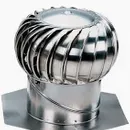Seeking references to true “active” sensor ridge vents, smart ridge vents, ridge vent alternatives.
Have you read a good article or research paper on smarter or adaptive ridge vents, or those based on variable flaps or electronic sensors?
Traditional ridge vents are of course entirely passive, so in that sense they can’t fail except when filled with leaves by squirrels. But how well they work is more mysterious.
Type of articles I’d like to read more might be “Wingnut testing using a fog machine”:
https://www.greenbuildingadvisor.com/article/wingnut-testing-of-soffit-to-ridge-venting-round-3
https://buildingscience.com/documents/published-articles/pa-eliminating-attic-vents/view
I work with a building that has turbine vents, which work dandy on days with a breeze in summer, but in winter almost immediately get drifted over with snow so don’t function at all.
I’m interested in any papers, studies or best of all apples to apples comparison test homes using vents that adapt based on humidity, temperature, wind speed or whatever. And considering a fan based system for winter.
GBA Detail Library
A collection of one thousand construction details organized by climate and house part










Replies
severaltypesofnerd,
The problem with turbine vents and extractor fans is that they depressurize the attic leading to more air-leakage from the house below. Avoiding that is also why the recommendation is that no more than 50% of the vents be located at the peak, and preferably less.
Having the vents stop functioning in winter isn't that big a problem, as sheathing is too cold to suffer either moisture damage, or grow mold.
I'm curious: why would you want to open and close the ride vent? What would a sensor measure?
The blocked turbine vent was just an example.
Short term I am interested in research in seasonal vents actually. Or ones that open and close based on demand (e.g. humidity) , for retrofitting vented cathedral ceilings to reduce energy loss. I'd like to know what's out there in research or white papers or...
Note in my home area climate winter is exactly when we get mold, due to daily cycling above and below freezing. Things depend a lot on climate and moisture balance.
I guess my question is: In what conditions would you want the vents closed? If you provide sufficient venting, why would you want to reduce it when the humidity was low enough that less venting would work? There is no real energy penalty associated with venting.
A discussion about snow blocking ridge vents: https://www.greenbuildingadvisor.com/question/ridge-vents-being-blocked-by-snow
A good overview putting in perspective whether it is worth getting too concerned about roof venting: https://www.greenbuildingadvisor.com/article/all-about-attic-venting
Attic venting isn't really something that influences attic energy loss. If your attic is properly insulated, the vent channels are completely outside of all insulating layers for the home. The different in "energy loss" you would achieve with controllable vents on the vent channels would be roughtly equivalent to the difference in energy loss between a calm day and a day with a light breeze.
The entire time the vents are closed, you'd be at elevated risk of moisture problems. Attic ventilation really needs to be continuous to be effective, if you are blocking it periodically, you're more likely to have problems. Controllable vents are also much more likely to have operational issues -- remember that even regular ridge and soffit vents can get clogged with insect debris, and they have no fancy operating mechanisms that can fail!
If you assume an air film to be about R1 or so, your controllable vents at most might gain you around R2 in theory (assuming an air film on both surfaces), but I suspect in practice it would be less than that, since the vent channel is going to be large enough to allow for significant convective air flow between the surfaces, and that will allow heat transfer through the vent channel at higher rates than if the air was static.
Bill